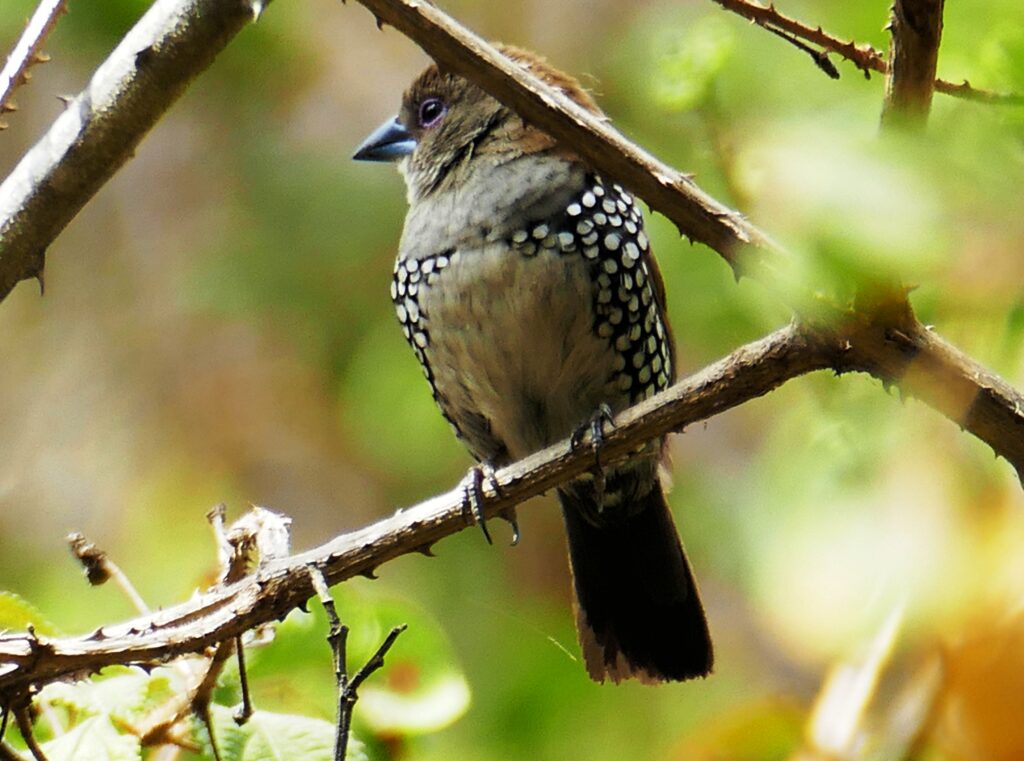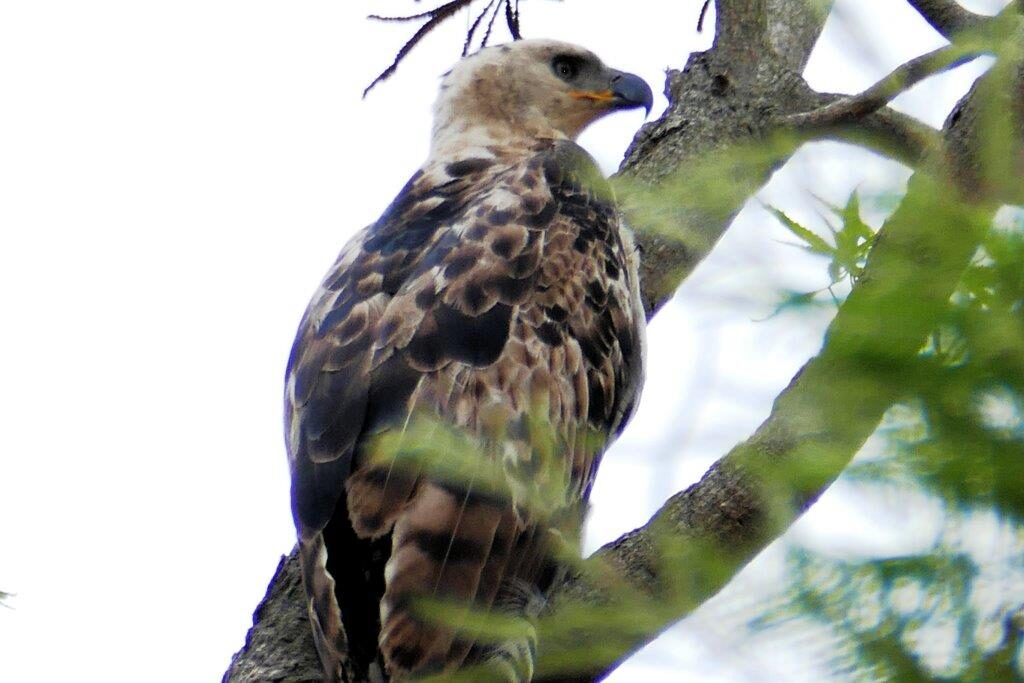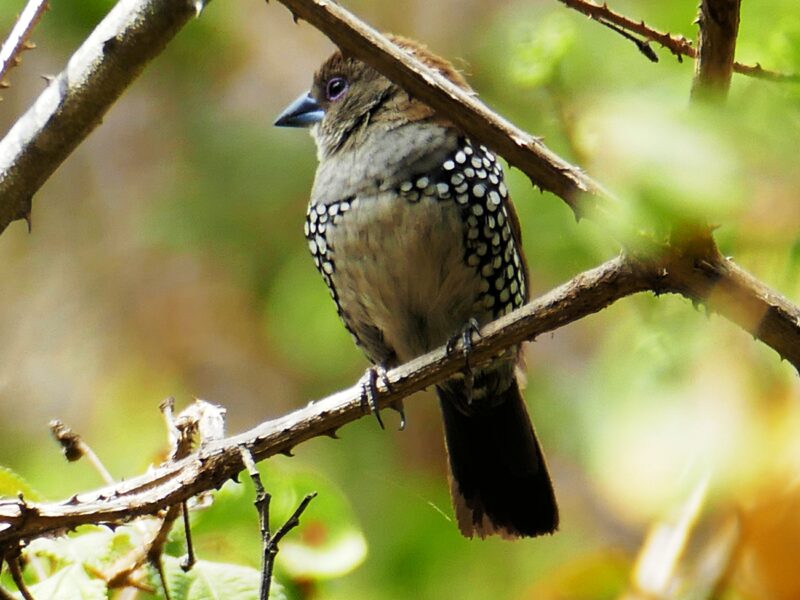
Pink-throated Twinspot female. Photo by Andy Nuns
On 6 September 2020, having heard of a Pink-throated Twinspot sighting in Barberton’s magnificent Mountainlands Nature Reserve, I organized a trip with a few birding buddies to try to find it. With most of us suffering from a severe dose of lockdown blues at the time this reported sighting provided much needed excitement and couldn’t have come at a better time.
The Pink-throated Twinspot (Hypargos margaritatus) is endemic to southern Africa. It occurs in Kwazulu-Natal,southern Mozambique, Swaziland, in the east of Mpumalanga and with a population in northern Limpopo Province. It is classified as Near-threatened in South Africa and Swaziland. Having established that the Twinspot seemed to favour mid-day for putting in an appearance, this left us with enough time for some birding beforehand and it was decided to split into two groups before we would meet up later again
Unfortunately, the weather was foul and as we set off in different directions it was overcast, very cold and not at all conducive to birding. Apart from a few African Firefinches and some very noisy Hadeda Ibis, a Mocking Chat and a few Buff-streaked chats a little further on, my group saw very little at this usually productive area. Bird calls were also in short supply and it remained very quiet until the sun finally made an appearance just before we met up with the other group.
With early sightings of both Broad-tailed warbler and Chorister Robin-Chat this group had much better luck. They also saw a pair of Verreaux’s Eagles – presumably the same pair that the Barberton Bird Club first recorded on 25 April 2015 and have been recorded several times subsequently. These magnificent eagles kept them entertained for some time as they appeared to be hanging around a remote rocky outcrop close to where we recorded Lanner Falcons breeding a few years ago and we look forward to exploring this area further during our next visit
On our way to the Twinspot site things started to look very promising when a raptor with a massive wing span flew right in front of us, very low, before disappearing round the bend . Fortunately, as we rounded the bend we saw it perched in a tree – not too far away – allowing us to take photographs and identify it as a juvenile Crowned Eagle. A few minutes later, we had another spectacular view when it flew over our vehicle but this time it was being viciously mobbed by three very noisy White-necked Ravens – that had appeared from nowhere – and wisely made a hasty retreat.

Crowned Eagle Juvenile. Photo by Andy Nuns
The weather was perfect as we travelled onwards and the birding was much improved. A flowering tree was teeming with a variety of sunbirds including Scarlet-chested, Collared, Amethyst and White-bellied . A beautiful Knysna Turaco was also seen at close quarters.
As planned, just after mid-day we arrived at the Twinspot site which turned out to be a pleasant woodland area with a seep providing a sheltered water supply and lots of thick and tangled scrub, favoured by these birds. Quiet as church mice, and with cameras and binoculars at the ready, we then waited patiently for the Twinspot to make an appearance. The constant movement of Drongos, White-eyes, and a variety of doves kept us on our toes but, alas, no Twinspot. We did, however, get a very good sighting of a Blue-mantled Crested Flycatcher flitting around in the trees in front of us.
Some time later, with no sign of the Twinspot yet, I decided to try another promising area a short distance away but again without success. Returning to the vehicle – completely unobserved from behind – I could sense that everyone was starting to feel a little despondent and concluded that a little excitement wouldn’t go amiss. So, without making my presence known, I softly played the Twinspot’s call and almost immediately binos could be seen pointing in all directions frantically trying to locate the bird. And then, appearing out of nowhere, there it was! The first Twinspot had finally arrived – at fairly close quarters – providing us with some perfect photographic opportunities with front, side and back views. In total three females were seen but, unfortunately, no male was recorded. Needless to say, we were so excited – and not so quiet anymore – after this wonderful sighting and a new record for the reserve.
Back at the top of the pass – where we were enjoying a late lunch – there was more excitement when we were all treated to the most wonderful sighting of the Verreaux’s Eagles with one being mobbed by a Rock Kestrel. How lucky we were – a perfect ending to a wonderful day that will long be remembered for the amazing time we had beating the lockdown blues.
Well done to Garry and Shirley Boyd who first spotted the Twinspot and a big thank you to Delia Oosthuizen for all her time and trouble – and for chauffeuring us around with such expertise on the challenging “Twinspot route” – all of which contributed to making this one of the best – if not the best – birding days in Mountainlands. Thank you also to the landowners and Mpumalanga Tourism and Parks Agency for ongoing access to this incredibly beautiful reserve which is always appreciated.
Marjorie Nuns
Barberton Bird Club
To date, a total of 281 different birds have been identified in the reserve and the latest bird checklist is available on the Mountainlands website. Property owners, and other visitors to Mountainlands, are requested to please report – and photograph where possible – any unusual bird sightings to Marjorie Nuns at anuns@icon.co.za.

